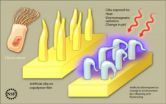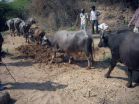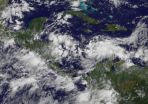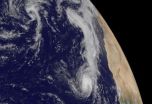(Press-News.org) In research led by a Saint Louis University surgeon, investigators found that women who give birth after suffering pelvic fractures receive C-sections at more than double normal rates despite the fact that vaginal delivery after such injuries is possible. In addition, women reported lingering, yet often treatable, symptoms following their pelvic fracture injuries, from urinary complications to post-traumatic stress disorder.
The study, published in Clinical Orthopaedics and Related Research, retrospectively reviewed the cases of 71 women who had suffered pelvic fractures, 26 of whom subsequently had children. Of those 26 women, 10 delivered vaginally and 16 gave birth by C-section.
More than 100,000 patients are treated for pelvic fractures each year in the U.S., most commonly after car accident injuries.
Lisa Cannada, M.D., associate professor of orthopaedic surgery subspecializing in traumatology at Saint Louis University and lead researcher, says the study offers important information women should discuss with their doctors.
"The C-section rate is so high. It's important to educate women and their obstetricians that it is possible to deliver vaginally after a pelvic fracture," said Cannada, who is also a SLUCare orthopaedic surgeon.
"Frequently, these issues are not addressed when women are first treated for a fracture. In some cases, women are given inaccurate information, such as being told not to become pregnant after a pelvic fracture or that they must have a C-section. This is not the case."
Researchers also found that, in addition to anxiety about future pregnancies, women expressed concern about symptoms related to their injuries and also frequently suffered from urinary symptoms and discomfort during sex.
"We've found that many women worry about whether or not they can have children and what type of delivery will be possible," Cannada said. "Women also worry about pain during sex and urinary issues."
In many cases, Cannada says, women do not realize their symptoms are related to the fracture they suffered. Urinary issues, sexual dysfunction and post-traumatic stress disorder all can follow a pelvic fracture.
Cannada says it's important for women to know that there are effective treatment options for these issues.
"Take charge," Cannada says. "Don't let a pelvic fracture affect your life or decision to have kids. Talk to your OB/GYN and find out what your best options are."
INFORMATION:
The study was funded by the Foundation for Orthopaedic Trauma and the Ruth Jackson Orthopaedic Society Zimmer Research Award.
Study highlights:
Pelvic fractures should not deter women from having children.
It is possible to deliver vaginally after a pelvic fracture.
Many women experience urinary symptoms or painful sex following a pelvic fracture. Women should consult their doctors because effective treatments are available.
Post-traumatic stress disorder is common after a trauma. It, too, has effective treatments.
Established in 1836, Saint Louis University School of Medicine has the distinction of awarding the first medical degree west of the Mississippi River. The school educates physicians and biomedical scientists, conducts medical research, and provides health care on a local, national and international level. Research at the school seeks new cures and treatments in five key areas: cancer, liver disease, heart/lung disease, aging and brain disease, and infectious disease.
Study finds high rate of c-sections after pelvic fractures
Saint Louis University researcher encourages women to talk to their doctors about options
2010-09-24
ELSE PRESS RELEASES FROM THIS DATE:
Caltech researchers design a new nanomesh material
2010-09-24
PASADENA, Calif.—Computers, light bulbs, and even people generate heat—energy that ends up being wasted. With a thermoelectric device, which converts heat to electricity and vice versa, you can harness that otherwise wasted energy. Thermoelectric devices are touted for use in new and efficient refrigerators, and other cooling or heating machines. But present-day designs are not efficient enough for widespread commercial use or are made from rare materials that are expensive and harmful to the environment.
Researchers at the California Institute of Technology (Caltech) ...
University of Nevada, Reno, demonstrates successful sludge-to-power research
2010-09-24
RENO, Nev. – Like the little engine that could, the University of Nevada, Reno experiment to transform wastewater sludge to electrical power is chugging along, dwarfed by the million-gallon tanks, pipes and pumps at the Truckee Meadows Water Reclamation Facility where, ultimately, the plant's electrical power could be supplied on-site by the process University researchers are developing.
"We are very pleased with the results of the demonstration testing of our research," Chuck Coronella, principle investigator for the research project and an associate professor of chemical ...
Groundwater depletion rate accelerating worldwide
2010-09-24
WASHINGTON– In recent decades, the rate at which humans worldwide are pumping dry the vast underground stores of water that billions depend on has more than doubled, say scientists who have conducted an unusual, global assessment of groundwater use.
These fast-shrinking subterranean reservoirs are essential to daily life and agriculture in many regions, while also sustaining streams, wetlands, and ecosystems and resisting land subsidence and salt water intrusion into fresh water supplies. Today, people are drawing so much water from below that they are adding enough ...
Cilia revolution
2010-09-24
University of Southern Mississippi scientists recently imitated Mother Nature by developing, for the first time, a new, skinny-molecule-based material that resembles cilia, the tiny, hair-like structures through which organisms derive smell, vision, hearing and fluid flow.
While the new material isn't exactly like cilia, it responds to thermal, chemical, and electromagnetic stimulation, allowing researchers to control it and opening unlimited possibilities for future use.
This finding is published in today's edition of the journal Advanced Functional Materials. The ...
Taking a new look at old digs: Trampling animals may alter Stone Age sites
2010-09-24
Archaeologists who interpret Stone Age culture from discoveries of ancient tools and artifacts may need to reanalyze some of their conclusions.
That's the finding suggested by a new study that for the first time looked at the impact of water buffalo and goats trampling artifacts into mud.
In seeking to understand how much artifacts can be disturbed, the new study documented how animal trampling in a water-saturated area can result in an alarming amount of disturbance, says archaeologist Metin I. Eren, a graduate student at Southern Methodist University, Dallas, and ...
High pressure experiments reproduce mineral structures 1,800 miles deep
2010-09-24
University of California, Berkeley, and Yale University scientists have recreated the tremendous pressures and high temperatures deep in the Earth to resolve a long-standing puzzle: why some seismic waves travel faster than others through the boundary between the solid mantle and fluid outer core.
Below the earth's crust stretches an approximately 1,800-mile-thick mantle composed mostly of a mineral called magnesium silicate perovskite (MgSiO3). Below this depth, the pressures are so high that perovskite is compressed into a phase known as post-perovskite, which comprises ...
Cancer-associated long non-coding RNA regulates pre-mRNA splicing
2010-09-24
CHAMPAIGN, Ill. — Researchers report this month that MALAT1, a long non-coding RNA that is implicated in certain cancers, regulates pre-mRNA splicing – a critical step in the earliest stage of protein production. Their study appears in the journal Molecular Cell.
Nearly 5 percent of the human genome codes for proteins, and scientists are only beginning to understand the role of the rest of the "non-coding" genome. Among the least studied non-coding genes – which are transcribed from DNA to RNA but generally are not translated into proteins – are the long non-coding RNAs ...
GOES-13 sees tropical depression 15 form in the south-central Caribbean Sea
2010-09-24
The fifteenth tropical depression of the Atlantic Ocean season has formed in the south-central Caribbean Sea, and the GOES-13 satellite captured its swirling mass of clouds and showers in a visible image today. Watches and warnings are already up for Central America.
At 2 p.m. EDT today, Sept. 23, Tropical Depression 15 had maximum sustained winds near 35 mph. It was located about 485 miles east of Puerto Cabezas, Nicaragua, near 13.9 North and 76.2 West. It was moving west at 15 mph, and had a minimum central pressure of 1007 millibars.
The government of Nicaragua ...
NASA sees important cloud-top temperatures as Tropical Storm Malakas heads for Iwo To
2010-09-24
NASA's Aqua satellite has peered into the cloud tops of Tropical Storm Malakas and derived just how cold they really are, giving an indication to forecasters of the strength of the storm.
The Atmospheric Infrared Sounder instrument, known as AIRS has the ability to determine cloud top and sea surface temperatures from its position in space aboard NASA's Aqua satellite. Cloud top temperatures help forecasters know if a storm is powering up or powering down.
When cloud top temperatures get colder it means that they're getting higher into the atmosphere which means the ...
NASA satellites help see ups and downs ahead for Depression Lisa
2010-09-24
Tropical Depression Lisa has had a struggle, and it appears that she's in for more of the same.
Infrared satellite imagery from the Atmospheric Infrared Sounder (AIRS) instrument on NASA's Aqua satellite shows that the convection (rapidly rising air that forms thunderstorms that make up a tropical cyclone) is increasing in Lisa. The convection is becoming a little better organized and stronger which is will make for some heavy rainfall over the northwestern Cape Verde Islands. It's also an indication that she may be strengthening back into a tropical storm today.
That ...
LAST 30 PRESS RELEASES:
Decoupling the HOR enhancement on PtRu: Dynamically matching interfacial water to reaction coordinates
Sulfur isn’t poisonous when it synergistically acts with phosphine in olefins hydroformylation
URI researchers uncover molecular mechanisms behind speciation in corals
Chitin based carbon aerogel offers a cleaner way to store thermal energy
Tracing hidden sources of nitrate pollution in rapidly changing rural urban landscapes
Viruses on plastic pollution may quietly accelerate the spread of antibiotic resistance
Three UH Rainbow Babies & Children’s faculty elected to prestigious American Pediatric Society
Tunnel resilience models unveiled to aid post-earthquake recovery
Satellite communication systems: the future of 5G/6G connectivity
Space computing power networks: a new frontier for satellite technologies
Experiments advance potential of protein that makes hydrogen sulfide as a therapeutic target for Alzheimer’s disease
Examining private equity’s role in fertility care
Current Molecular Pharmacology achieves a landmark: real-time CiteScore advances to 7.2
Skeletal muscle epigenetic clocks developed using postmortem tissue from an Asian population
Estimating unemployment rates with social media data
Climate policies can backfire by eroding “green” values, study finds
Too much screen time too soon? A*STAR study links infant screen exposure to brain changes and teen anxiety
Global psychiatry mourns Professor Dan Stein, visionary who transformed mental health science across Africa and beyond
KIST develops eco-friendly palladium recovery technology to safeguard resource security
Statins significantly reduce mortality risk for adults with diabetes, regardless of cardiovascular risk
Brain immune cells may drive more damage in females than males with Alzheimer’s
Evidence-based recommendations empower clinicians to manage epilepsy in pregnancy
Fungus turns bark beetles’ defenses against them
There are new antivirals being tested for herpesviruses. Scientists now know how they work
CDI scientist, colleagues author review of global burden of fungus Candida auris
How does stroke influence speech comprehension?
B cells transiently unlock their plasticity, risking lymphoma development
Advanced AI dodel predicts spoken language outcomes in deaf children after cochlear implants
Multimodal imaging-based cerebral blood flow prediction model development in simulated microgravity
Accelerated streaming subgraph matching framework is faster, more robust, and scalable
[Press-News.org] Study finds high rate of c-sections after pelvic fracturesSaint Louis University researcher encourages women to talk to their doctors about options









